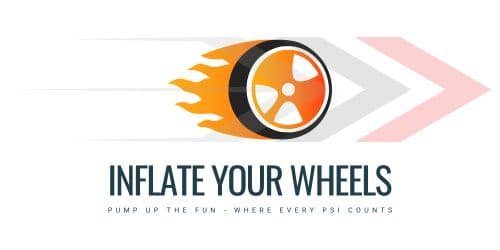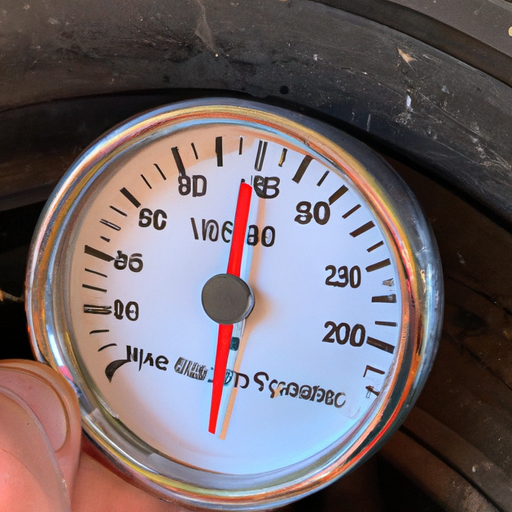Have you ever wondered if your tire pressure is too high? We were curious too, so we decided to investigate the matter. In this article, we will explore the question, “Is 36 psi too high for tires?” We will discuss the potential effects of overinflating your tires and provide you with some helpful insights on maintaining the optimal tire pressure for a smoother and safer ride. So, sit back, relax, and let’s uncover the truth about tire pressure!
Is 36 Psi Too High For Tires?
Table of Contents

Effects of Overinflated Tires
Decreased Contact Patch with the Road
When a tire is overinflated, it has a smaller contact patch with the road. This means that the surface area of the tire in contact with the road is reduced. As a result, the tire is less able to grip the road, leading to decreased traction and stability. This can have a significant impact on the vehicle’s handling and control, especially during turns or when driving on slippery surfaces.
Reduced Traction and Stability
Overinflated tires also suffer from reduced traction and stability. The excessive air pressure can cause the tire to become stiff, leading to a loss of flexibility and grip. This can be particularly dangerous in wet or icy conditions, as the tire’s ability to channel water or provide sufficient traction on slippery surfaces is compromised. It can result in increased skidding and an overall decrease in the vehicle’s stability.
Increased Wear on the Center of the Tread
Another effect of overinflated tires is increased wear on the center of the tread. When tires are overinflated, the center of the tread is subjected to increased pressure and bears the majority of the weight of the vehicle. This causes the center of the tread to wear down more quickly than the outer edges, resulting in uneven tire wear.
Uneven Tire Wear
In addition to increased wear on the center of the tread, overinflated tires can also cause uneven tire wear across the entire tread surface. The excessive air pressure can cause the tire to bulge outward in the center, leading to accelerated wear in that area. On the other hand, the outer edges of the tread may not make sufficient contact with the road, resulting in less wear in those areas. This can lead to a shorter tire lifespan and the need for premature tire replacement.
Impact on Ride Comfort
Overinflated tires can have a significant impact on ride comfort. The excessive air pressure can make the tires feel hard and rigid, resulting in a harsh and uncomfortable ride. This is particularly noticeable when driving over bumps or uneven road surfaces, as the tires are less able to absorb the impact and provide a cushioning effect. The lack of flexibility and shock absorption can make the ride feel jarring and less pleasant for both the driver and passengers.
Impacts on Fuel Efficiency
Increased Rolling Resistance
Overinflated tires also contribute to increased rolling resistance. Rolling resistance refers to the force required to keep the tire in motion. When a tire is overinflated, it becomes harder and less flexible, increasing the amount of effort required to keep it rolling. This results in higher fuel consumption, as the engine needs to work harder to overcome the increased resistance and keep the vehicle moving.
Decreased Gas Mileage
As a consequence of the increased rolling resistance, overinflated tires can lead to decreased gas mileage. The engine’s increased effort to overcome the resistance requires more fuel to be consumed, leading to reduced efficiency. This means that the vehicle will require more frequent refueling, resulting in higher fuel expenses in the long run. Overinflated tires not only harm the environment due to increased fuel consumption but also take a toll on your wallet.
Safety Concerns
Reduced Handling and Control
One of the most critical safety concerns with overinflated tires is the reduced handling and control they cause. When a tire is overinflated, it becomes less pliable and less able to conform to the road’s contours. This can result in a loss of grip, especially during abrupt maneuvers or emergency situations. The vehicle may become more difficult to steer and may exhibit increased understeer or oversteer tendencies. These handling issues can significantly impact the driver’s ability to maintain control of the vehicle, potentially leading to accidents or collisions.
Risk of Tire Blowouts
Overinflated tires increase the risk of tire blowouts. The excess pressure places additional strain on the tire’s structure, weakening it over time. This can lead to a catastrophic failure, where the tire bursts or separates while driving. Tire blowouts can cause the driver to lose control of the vehicle, potentially leading to a serious accident. Regularly checking and maintaining the proper tire pressure is crucial to reduce the risk of blowouts and ensure safe driving conditions.
Increased Braking Distance
Overinflated tires can also result in increased braking distances. When a tire is overinflated, it has less surface area in contact with the road, reducing its ability to provide sufficient grip for effective braking. This can significantly extend the distance required to bring the vehicle to a complete stop, especially in emergency situations. The increased braking distance poses a significant safety risk, as the driver may not be able to stop the vehicle in time to avoid a collision.
Manufacturer’s Recommended Tire Pressure
Understanding Tire Pressure Ratings
Tire pressure ratings specify the recommended air pressure for a particular tire. They are typically measured in pounds per square inch (psi) and can be found on the sidewall of the tire or in the vehicle’s manual. It is essential to understand that different tires have different recommended pressure ratings based on factors such as size, load capacity, and intended use. Following the manufacturer’s recommended tire pressure is crucial for optimal performance, safety, and longevity of the tire.
Importance of Following Manufacturer’s Recommendations
It is highly recommended to follow the tire pressure recommendations provided by the tire manufacturer and vehicle manufacturer. These recommendations are based on extensive testing and engineering to ensure that the tires perform optimally under various conditions. By adhering to these recommendations, you can enhance the vehicle’s handling, stability, fuel efficiency, and overall safety. Failure to follow the manufacturer’s recommendations can result in subpar performance, increased risks, and potential damage to the tires.
Factors Affecting Tire Pressure
Temperature Changes
Temperature changes can significantly impact tire pressure. As the temperature increases, the air inside the tire expands, leading to a higher pressure reading. Conversely, as the temperature decreases, the air contracts, resulting in a lower pressure reading. It is crucial to monitor tire pressure regularly, especially during extreme weather conditions, to ensure that the tire pressure remains within the recommended range. Adjustments may be necessary to maintain optimal performance and safety.
Load and Weight Distribution
Tire pressure is also affected by the load and weight distribution within the vehicle. Heavier loads place more stress on the tires, causing them to compress and deform. This can lead to increased tire temperatures and potentially result in overinflation. On the other hand, lighter loads may result in underinflated tires. Balancing the load and ensuring proper weight distribution is essential to maintain the correct tire pressure for optimal performance and safety.
Driving Conditions
Different driving conditions can impact tire pressure as well. Off-road driving or driving on rough terrains can cause the tires to experience more significant impacts and variations in pressure. High-speed driving or frequent hard braking can also increase tire temperatures, potentially resulting in overinflation. It is important to consider the driving conditions and adjust tire pressure accordingly to ensure safe and optimal tire performance.
Measuring and Adjusting Tire Pressure
Using a Tire Pressure Gauge
To measure tire pressure accurately, it is essential to use a tire pressure gauge. A tire pressure gauge is a simple handheld tool that allows you to measure the air pressure inside the tire. To use a tire pressure gauge, remove the valve cap from the tire’s valve stem, firmly press the gauge onto the stem, and read the pressure displayed on the gauge. Repeat this process for each tire to ensure all tires are properly inflated.
Determining the Correct Tire Pressure
To determine the correct tire pressure, refer to the manufacturer’s recommendations. These can typically be found in the vehicle’s manual, on a sticker inside the driver’s door jamb, or on the sidewall of the tire. The recommended tire pressure may vary depending on factors such as tire size, load capacity, and driving conditions. It is important to note that the maximum tire pressure embossed on the tire sidewall is not the same as the recommended pressure for normal driving conditions.
Adjusting Tire Pressure
To adjust tire pressure, you will need an air compressor or access to a service station with an air pump. If the tire pressure is too high, release some air by pressing the valve stem’s center pin with a small tool or the end of a tire pressure gauge. If the tire pressure is too low, add air by connecting the air pump to the valve stem and allowing air to fill the tire. Remember to check the pressure with the tire pressure gauge frequently during the process to ensure you reach the proper pressure level.
Effects on Tire Lifespan
Reduced Mileage
Overinflated tires can lead to reduced tire lifespan and mileage. The excessive air pressure causes the tire’s center tread to wear down more quickly, resulting in a shorter overall lifespan. This means that you may need to replace your tires more frequently, resulting in increased expenses. By maintaining the correct tire pressure, you can ensure even wear across the tire tread, potentially extending their lifespan and reducing the frequency of tire replacements.
Increased Risk of Tire Failure
Overinflated tires are at a higher risk of tire failure. The excessive pressure places additional stress on the tire’s structure, resulting in a weakened tire over time. This can increase the likelihood of punctures, blowouts, or other tire failures while driving. Tire failures can be dangerous, especially at high speeds, as they can cause loss of control and accidents. Keeping your tires properly inflated reduces the risk of tire failure and enhances overall safety on the road.
The Optimal Tire Pressure
Finding the Right Balance
To determine the optimal tire pressure, it is crucial to find the right balance between underinflation and overinflation. Underinflated tires can lead to decreased fuel efficiency, reduced handling, and increased tire wear on the sidewalls. Overinflated tires, as discussed earlier, can lead to reduced traction, uneven tire wear, decreased ride comfort, and safety concerns. By following the manufacturer’s recommended tire pressure, you can strike the right balance and promote optimal tire performance, safety, and longevity.
Consulting the Vehicle’s Manual or Tire Manufacturer
The vehicle’s manual or the tire manufacturer’s recommendations should always be consulted when determining the optimal tire pressure. These sources have the most accurate and specific information for your particular make and model of vehicle. The recommended tire pressures take into account factors such as vehicle weight, tire size, load capacity, and performance expectations. By following these recommendations, you can ensure that your tires are properly inflated for the best possible performance and safety.
Other Commonly Asked Questions
Can Overinflated Tires Cause a Blowout?
Yes, overinflated tires can increase the risk of a tire blowout. The excessive air pressure places strain on the tire’s structure, weakening it over time. This can lead to a catastrophic failure, where the tire bursts or separates while driving. Regularly checking and maintaining the proper tire pressure within the recommended range can help reduce the risk of tire blowouts and ensure safe driving conditions.
Can Overinflated Tires Cause a Dull Ride?
Yes, overinflated tires can cause a dull and uncomfortable ride. The excessive air pressure makes the tires feel hard and rigid, resulting in reduced shock absorption and less ability to absorb bumps and vibrations. This can make the ride feel harsh and less pleasant for both the driver and passengers. It is important to maintain the correct tire pressure to ensure a smooth and comfortable driving experience.
What Should I Do If My Tires Are Overinflated?
If your tires are overinflated, it is important to reduce the air pressure to the recommended level. You can release air from the tire by pressing the center pin of the valve stem with a small tool or the end of a tire pressure gauge. It is essential to check the tire pressure frequently during the process to ensure that you reach the proper pressure level. If you are unsure or uncomfortable adjusting the tire pressure yourself, it is recommended to visit a professional tire service center.
Is 36 Psi the Maximum Tire Pressure?
The maximum tire pressure is typically marked on the sidewall of the tire. However, it is important to note that this value represents the tire’s maximum allowable pressure, mainly used for specific situations such as carrying heavy loads. The recommended tire pressure for normal driving conditions is typically lower than the maximum tire pressure. To determine the correct tire pressure, consult the vehicle’s manual or the manufacturer’s recommendations.
Conclusion
Maintaining the correct tire pressure is essential for optimal performance, safety, and tire longevity. Overinflated tires can have various negative effects, including decreased contact patch with the road, reduced traction and stability, increased wear on the center of the tread, uneven tire wear, impact on ride comfort, decreased fuel efficiency, safety concerns, and impacts on tire lifespan.
By understanding the manufacturer’s recommended tire pressure, factors affecting tire pressure, and the importance of regular checks and adjustments, you can ensure that your tires remain in optimal condition and provide a safe and comfortable driving experience. Remember to consult the vehicle’s manual or tire manufacturer for specific recommendations and always aim for the right balance in tire pressure.


Keep your car tires in peak condition with the right inflator.
Discovering the best tire inflator can be a game-changer for maintaining your vehicle. Explore our comprehensive Ultimate Guide to the Best Tire Inflators to make an informed decision.

